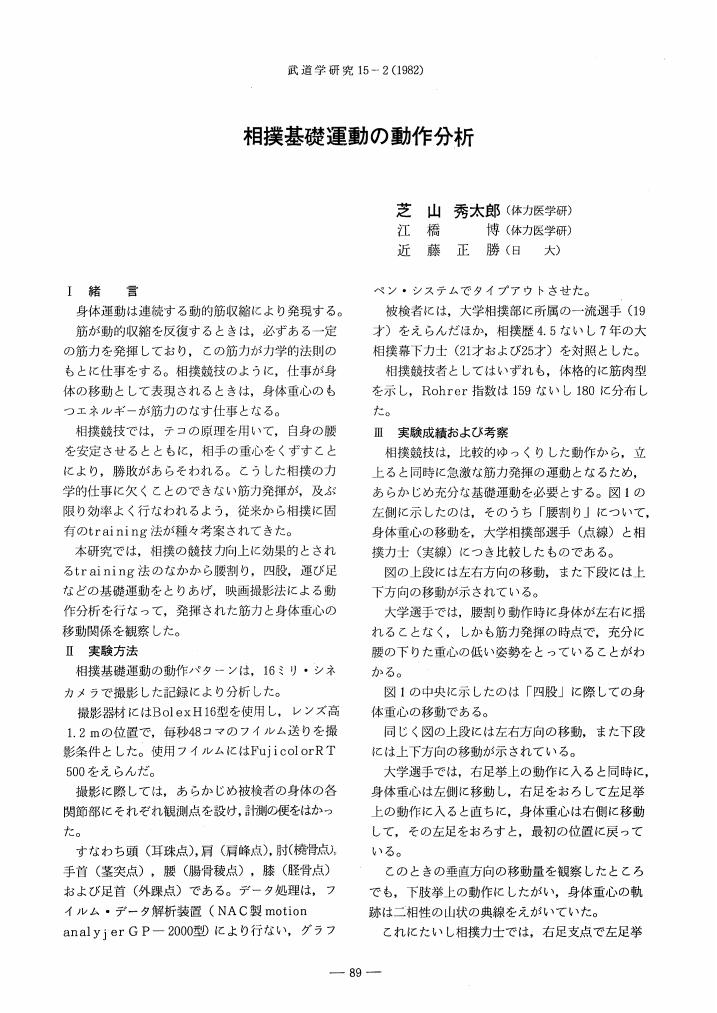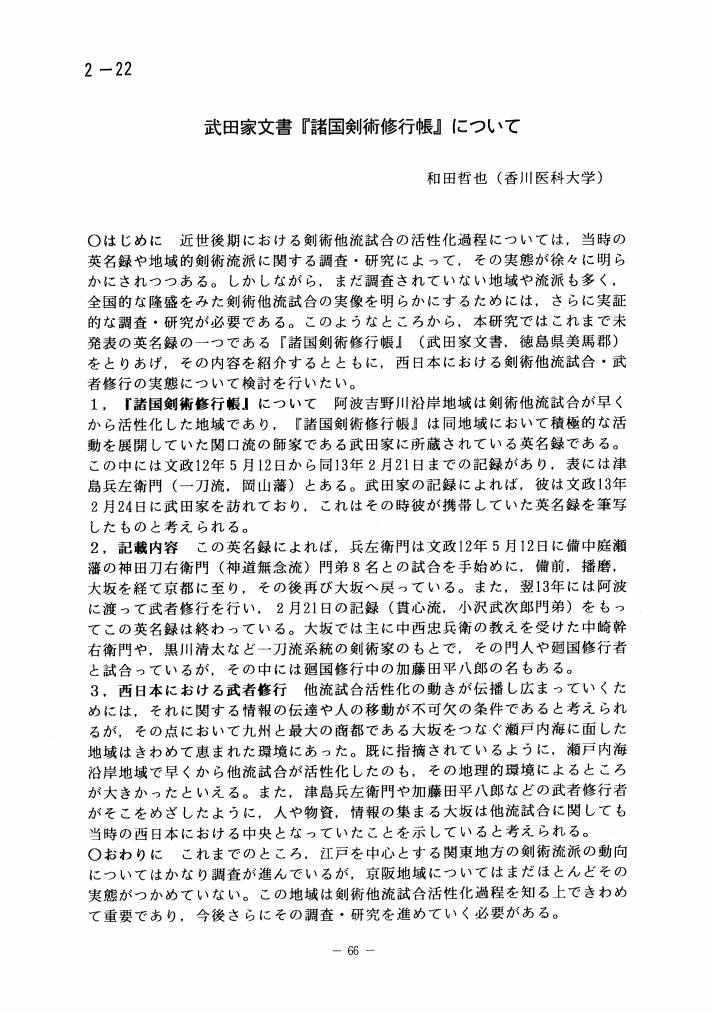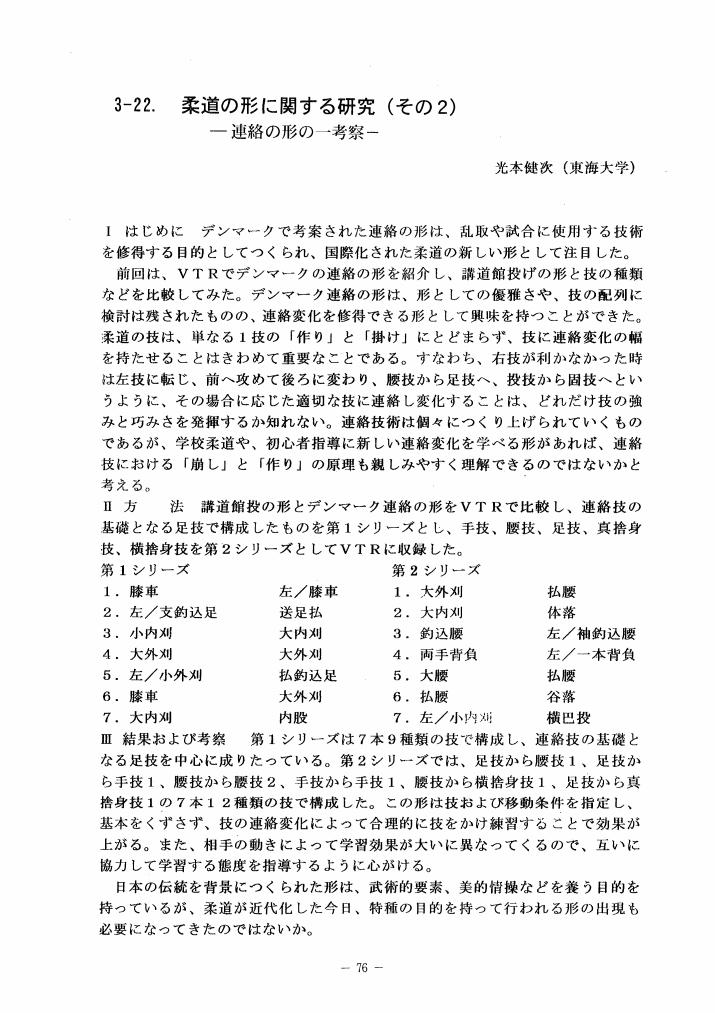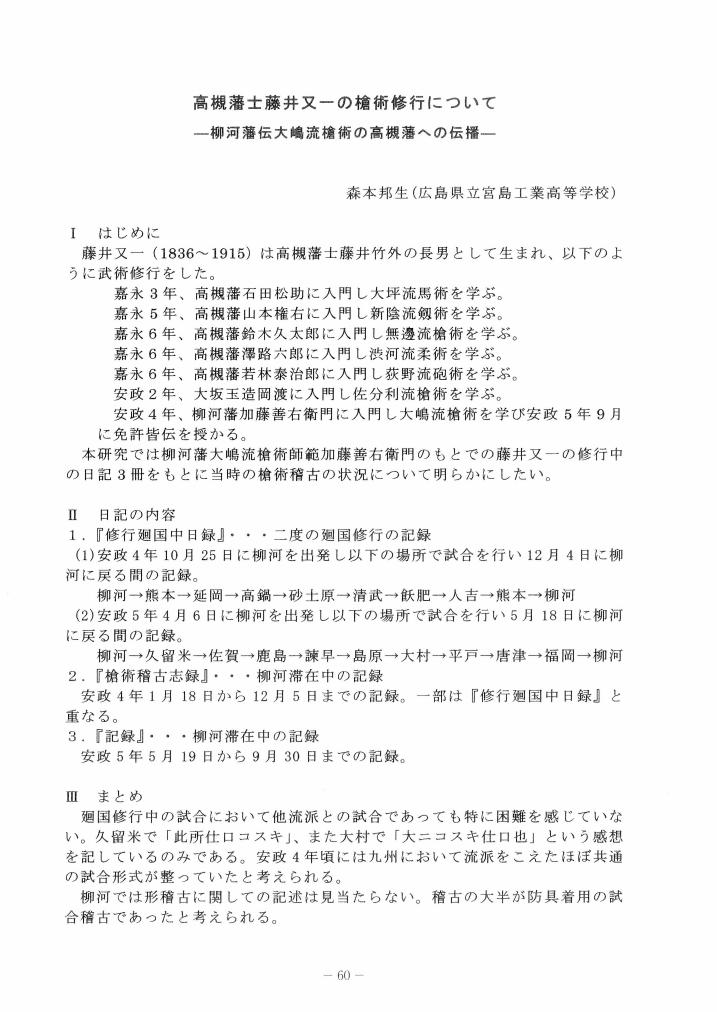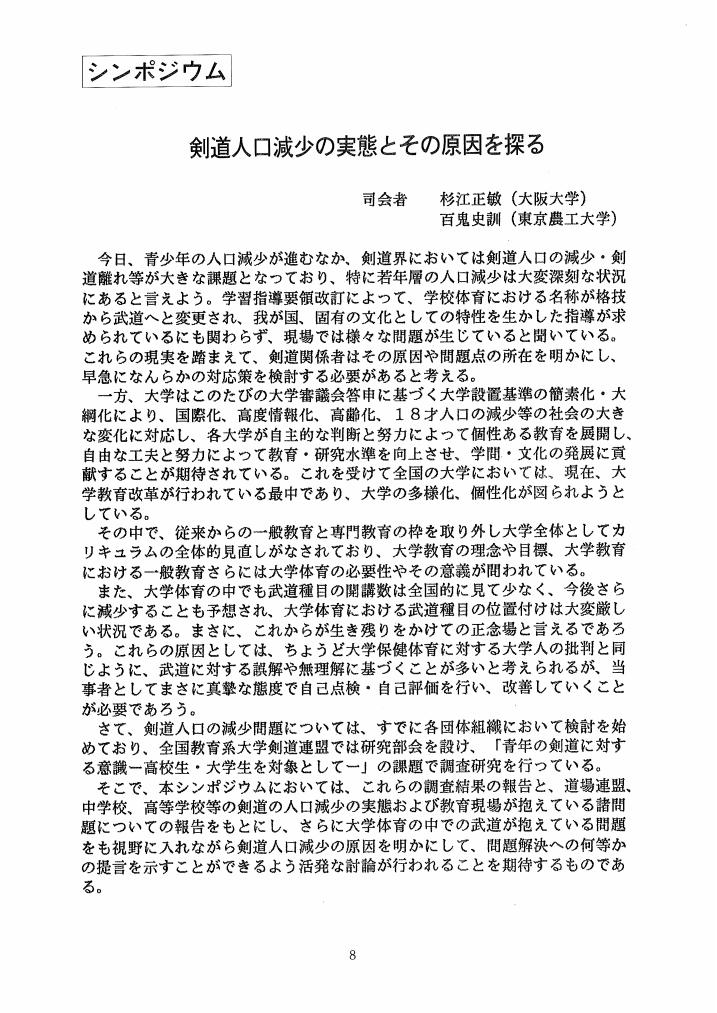1 0 0 0 OA 武芸における「気」に関する諸問題―身体論的視座から―
- 著者
- 大保木 輝雄
- 出版者
- 日本武道学会
- 雑誌
- 武道学研究 (ISSN:02879700)
- 巻号頁・発行日
- vol.16, no.3, pp.15-21, 1984-03-30 (Released:2012-11-27)
- 参考文献数
- 27
The purpose of this paper is to clarify the characteristics of “Ki” (Energy), considered as being the most important concept in traditional theories on martial arts.From his readings and classification and arrangement of the “Ki” terms appearing in the typical works of swordsmen during the Edo era (AD 1600-1867), the author tries to clarify the characteristics of “Ki” in the Martial Arts.The results of this paper may be summarized as follows:1) Swordsmen grasped the matter in relation to phenomenon and essence and not in relation to cause and effect.2) They recognized that “Ki” controls not only their mind and body but also the whole creation.3) They defined the concept of “Ki” as an abstract idea, functional ontological concept and the real existence which appeared in their mind and body.4) They could have the intuition of the essence of “Ki” by training their body and mind in Martial Arts, especially in the situation where they were facing each other holding their Katana.5) They solved the “mind-body” problem by means of the transformation of themselves through the mastering of “Ki”.
1 0 0 0 OA 相撲基礎運動の動作分析
1 0 0 0 OA 樫原系槍術の研究
- 著者
- 村林 正美
- 出版者
- 日本武道学会
- 雑誌
- 武道学研究 (ISSN:02879700)
- 巻号頁・発行日
- vol.20, no.2, pp.77-78, 1987-11-30 (Released:2012-11-27)
1 0 0 0 インドのバラモン武術=ヴァジラムスティ
- 著者
- 岡田 明憲
- 出版者
- 武道学研究
- 雑誌
- 武道学研究 (ISSN:02879700)
- 巻号頁・発行日
- vol.19, no.2, pp.89-90, 1986
1 0 0 0 OA 身体各部分の加速度からみた柔道の受け身
- 著者
- 真柄 浩 内匠屋 潔
- 出版者
- 日本武道学会
- 雑誌
- 武道学研究 (ISSN:02879700)
- 巻号頁・発行日
- vol.9, no.3, pp.15-22, 1977-03-31 (Released:2012-11-27)
- 参考文献数
- 22
Ukemi movements against migi-tsurikomigoshi were analyzed by 16 mm kinematography and acceleration transducer in order to obtain some informations usefull in effective instruction of Ukemi in Judo.Movements of Ukemi were considered all complete with in approximately 0.3 sec. There found `pronounced discrepancies between the recorded values and the values claimed by the subjects in their feeling as to the time of completion, sequence of the body parts hitting the mat, and the angle formed between the. arm and the side of the trunk.Subject T. T. whose performance in Ukemi was rated excellent, registered a double hitting on the mat with his left arm which reduced the landing shock to the neck markedly. The highest angular velocity of his neck was 530°J sec.Subject Y. S. whose Ukemi performance was rated very poor, showed pushing movement against the mat rather than the hitting movement in his left arm. The landing shock to his neck was great, as recorded in the angular velocity of his neck which reached 1260°/sec.It was concluded that: (1) avoidance of the confusion between the mechanical phenomena actually took place and the subjective feeling of the performance is necessary; (2) function of absorbing the impact with viscosity and elasticity must be considered; in order to improve the effectiveness of instruction in Ukemi.
1 0 0 0 OA 日本統治下台湾における弓道の導入と普及実態:弓道団体の進出を中心として
- 著者
- 五賀 友継 洪 子甯 松尾 牧則
- 出版者
- 日本武道学会
- 雑誌
- 武道学研究 (ISSN:02879700)
- 巻号頁・発行日
- pp.2107, (Released:2021-12-15)
- 参考文献数
- 90
The aim of this study was to clarify how kyudo was introduced and disseminated in Taiwan during the period of Japanese rule from 1895 to 1945.The first approach in investigating how kyudo began in Taiwan was by analyzing the local newspaper articles published during the period. It was found that the very first “Daikyujo” was established in Taipei in 1896, where kyudo activities first appeared. Some of the “Daikyujo” in this early period were for the purpose of physical exercise and training, while others were similar to “Yabaeigyo”, where the customers were charged to do kyudo as a form of entertainment.Next, understanding how the foundation was laid for the spread of kyudo in Taiwan was conducted by researching the role that the Dai Nippon Butoku Kai (DNBK) and the Dai Nippon Kyudo Kai (DNKK) played at the time. In the Taiwan branch of DNBK, the department of kyujutsu was established at the Taipei Chihou Iinbu (Taipei Regional Committee), which was the predecessor of the Taiwan branch of the DNBK, in 1901. This marked the beginning of kyudo practice on the island. However, the kyujutsu department was transferred out of the DNBK to Taiiku Club in 1903 and was temporarily separated from the DNBK. After the dissolution of Taiiku Club in 1916, it returned to the DNBK. Around the same time, the DNKK established its first branch in Takao (Kaohsiung) in 1915, but local promotion activities only began in earnest from 1924, after the visit of Kako NEYA, the founder of the DNKK. Subsequently, Seiko OIZUMI, a master of the DNKK, was stationed in Taiwan and further promoted the spread of kyudo.Lastly, the geographical locations and establishment timeline of the Kyudo group, mainly established by the DNBK and DNKK in Taiwan over the period of Japanese rule, were analyzed to identify the extent of the spread of kyudo in the region at the time. It was found that Kyudo group was not only established in urban areas on the west coast of the main island, but also on the less populated east coast, central mountainous areas, and remote islands. In particular, the DNKK accounts for 30% of the kyudo groups in total. On the other hand, it was not clear whether the DNBK had successfully spread to those regions. In addition, it was observed that a high concentration of kyudo organizations established in southern Taiwan were affiliated with the sugar industry. Besides the DNBK and DNKK, the Dai Nippon Shakakuin was another kyudo organization that had its branch in Taipei, but its influence was limited.
1 0 0 0 OA 武田家文書『諸国剣術修行帳』について
- 著者
- 和田 哲也
- 出版者
- 日本武道学会
- 雑誌
- 武道学研究 (ISSN:02879700)
- 巻号頁・発行日
- vol.25, no.Supplement, pp.66, 1992 (Released:2012-11-27)
1 0 0 0 竹内流腰の廻り創始にみる初期柔術の生成過程
- 著者
- 老松 信一
- 出版者
- Japanese Academy of Budo
- 雑誌
- 武道学研究 (ISSN:02879700)
- 巻号頁・発行日
- vol.2, no.2, pp.18-23, 1970
1 0 0 0 OA 武道とポピュラー文化
- 著者
- 井上 俊
- 出版者
- 日本武道学会
- 雑誌
- 武道学研究 (ISSN:02879700)
- 巻号頁・発行日
- vol.50, no.Supplement, pp.S_8-S_9, 2017 (Released:2019-01-23)
1 0 0 0 OA 競技特性からみた剣道におけるスポーツ傷害の分析
- 著者
- 和久 貴洋 河野 一郎 中村 充 三輪 一義 香田 泰子 香田 郡秀 佐藤 成明
- 出版者
- 日本武道学会
- 雑誌
- 武道学研究 (ISSN:02879700)
- 巻号頁・発行日
- vol.24, no.1, pp.45-51, 1991-07-31 (Released:2012-11-27)
- 参考文献数
- 23
- 被引用文献数
- 2
The purpose of this study was to examine the measures to prevent injuries and to improve performance of Kendo by analyzing injuries due to Kendo from practice condition and athletic specificity. The findings were collected from a survey by questionnaire on injuries due to Kendo. The following results were obtained. Thirty-eight out of forty-four Kendo players (college players) had experience in injuries due Kendo in the past. Most Kendo players were injuried in college. Most Kendo players were injuried during practice of Kendo (Jigeiko, Kakarigeiko, or Shiaigeiko) in the middle or the latter half at practice of Kendo. Most of injuries were myorrhexis, plasmotomy of the tendon, tendovaginitis, sprain, stress fracture, spondylolysis, lumbago and bruise. The higher occurence parts of injuries due to Kendo were ankle and wrist joints, the tendo calcaneus (Achilles), crus, thigh and regio lumbalis. Many injuries of crus, the tendon of Achiles and wrist joint were in the left, although injuries of ankle joint were in the right. Fiftysix percent of all injuries were caused by fatigue and the fatigue was occured by Tobikomi action, Suburi action, or Taiatari during Jigeiko and Kakarigeiko in the latter half at practice of Kendo. These were concluded that injuries due to Kendo can be prevented by master of correct Datotsu technique, the measure to fatigue, forming appropriate training plan and the systematization of staff for first aid and that the weight training to the higher occurence parts of injuries due to Kendo was needed for prevention of injuries and improvement in performance of Kendo.
1 0 0 0 OA 柔道の形に関する研究(その2)―連絡の形の一考察―
- 著者
- 光本 健次
- 出版者
- 日本武道学会
- 雑誌
- 武道学研究 (ISSN:02879700)
- 巻号頁・発行日
- vol.31, no.Supplement, pp.76, 1998 (Released:2012-11-27)
- 著者
- 和田 哲也
- 出版者
- Japanese Academy of Budo
- 雑誌
- 武道学研究 (ISSN:02879700)
- 巻号頁・発行日
- vol.23, no.2, pp.177-178, 1990
- 著者
- 和田 哲也
- 出版者
- Japanese Academy of Budo
- 雑誌
- 武道学研究 (ISSN:02879700)
- 巻号頁・発行日
- vol.25, no.2, pp.13-23, 1992
Sekiguchi-ryu of Takeda family was a kenjyutsu-school transmitted in the Yoshino-river area in the province of Awa. In this school “taryu-jiai” was practiced vigorously with the new training method, “shinai-uchikomi-geiko”, in the latter period of Edo era. Almost all of the “densho-rui”, the traditional writings, of the Sekiguchi-school are owned by the descendants now. There were many martial arts schools whose “densho-rui” have been lost by now, so the Sekiguchi-school seems to be a quite important case for us to know the whole “densho-rui” of martial arts school. In this paper I intended to clarify the kind of “densho-rui”, their awarding order, and the relation berween the new training method and the traditional awarding order of the Sekiguchi school during the period of shifting from the old training method to the new one. The results can be summarized as follows: (1) The number of the kind of “densho-rui” in this school which are confirmed by now is about fifty. Among these, eleven kinds of “denjyu-jyo” and “sho-jyo” which were from “Sekigwchi-ryu-hachikajyo”to “Injyu”, formed the traditional awarding order of this school, and were transmitted orderly to the disciples. (2) Six Kinds of “senkyo-jyo” were “sho-jyo” to recognize the six classes of this school which were established at the end of the 18th century. The skillfullness of the technique of the new training method regarded considerably important object to recognize the classes. (3) The traditional awarding order of the Sekiguchi-school was not changed or abolished after the establishment of the six classes. Nevertheless the significance of the traditional “waza” and awarding order based on it disapeared gradually. (4) “Toritate-seido” of the Sekiguchi-school was a characteristic form to instruct the disciples and to operate the martial arts school, and had a kind of character of “iemoto-seido”. “Toritate-seido” had been made because the new trainning method came to be practiced mainly in the Sekiguchi-school.
1 0 0 0 OA 高槻藩士藤井又一の槍術修行について ―柳河藩伝大嶋流槍術の高槻藩への伝播―
- 著者
- 森本 邦生
- 出版者
- 日本武道学会
- 雑誌
- 武道学研究 (ISSN:02879700)
- 巻号頁・発行日
- vol.43, no.Supplement, pp.60, 2010 (Released:2014-04-04)
1 0 0 0 OA 日中戦争以降における武道の戦技化の起源とその背景:武道振興委員会の審議過程の分析
- 著者
- 中嶋 哲也
- 出版者
- 日本武道学会
- 雑誌
- 武道学研究 (ISSN:02879700)
- 巻号頁・発行日
- vol.49, no.2, pp.95-107, 2016-11-30 (Released:2018-03-12)
- 参考文献数
- 15
Only a few historical studies have examined Japan’s martial arts during the Second Sino-Japanese War of 1937-1945. Those studies that do exist tend to focus on the controversy surrounding “sengika,” or the militarization of martial arts. Extant research has documented that sengika was recommended by the Martial Arts Promotion Committee (MAPC), which was instituted by the government as an advisory body in December 1939. Previous research indicates that the commissioners of the MAPC were not universally enthusiastic about sengika. The purpose of this study is to delineate the process by which internal opposition to sengika was transformed into support on the committee.This research has yielded the following results: the commissioners originally critical of the sengika came to concur that martial arts could have useful military applications. They emphasized the combative effectiveness of martial arts that is not evident in sport-oriented practices, and aimed to distinguish between the martial arts and sports with the intention of protecting the uniqueness of Japanese martial arts. This stance, however, prevented them from offering a protest against sengika.One area for further investigation is why those officials intent on preventing the Westernization of martial arts (making them into sports) chose to make the combative effectiveness of martial arts their central issue. Subsequent research on the role of martial arts during wartime will need to address in greater detail this effort to prevent the treatment of martial arts as sport.
- 著者
- 光本 健次
- 出版者
- Japanese Academy of Budo
- 雑誌
- 武道学研究 (ISSN:02879700)
- 巻号頁・発行日
- vol.30, pp.37, 1997
1 0 0 0 柔道の形に関する研究(その2)―連絡の形の一考察―
- 著者
- 光本 健次
- 出版者
- Japanese Academy of Budo
- 雑誌
- 武道学研究 (ISSN:02879700)
- 巻号頁・発行日
- vol.31, pp.76, 1998
1 0 0 0 OA シンポジウム 剣道人口減少の実態とその原因を探る
- 出版者
- 日本武道学会
- 雑誌
- 武道学研究 (ISSN:02879700)
- 巻号頁・発行日
- vol.27, no.Supplement, pp.8-12, 1994 (Released:2012-11-27)
